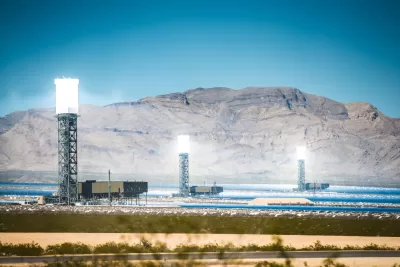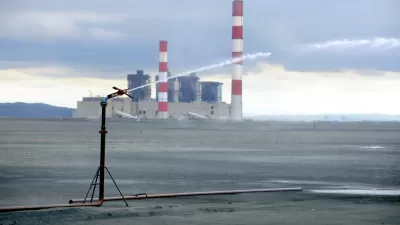On Tuesday, EPA released its new rule to regulate emissions from existing power plants, essentially leaving it to the states to determine appropriate emissions levels rather than setting actual standards each state has to meet like the current rule.

There may be a new leader at the helm of the U.S. Environmental Protection Agency, but the goal of erasing the environmental legacy of President Obama continues without interruption. Rather than focusing on reducing greenhouse gas (GHG) and criteria pollutant emissions and protecting public health and the environment, the EPA's press release reads like it came from the Department of Energy as its two priorities appear to be the affordability and reliability of energy.
This proposal, entitled the Affordable Clean Energy (ACE) Rule, establishes emission guidelines for states to use when developing plans to limit GHGs at their power plants. The ACE Rule replaced the prior administration’s overly prescriptive and burdensome Clean Power Plan (CPP) and instead empowers states, promotes energy independence, and facilitates economic growth and job creation.
The emphasis on affordability resembles another landmark regulation rollback announced this month by the Environmental Protection Agency and the U.S. Department of Transportation: the proposed Safer Affordable Fuel-Efficient (SAFE) Vehicles Rule that freezes greenhouse gas emission and fuel economy standards for model years 2021 to 2026.
"The new proposal ... seeks to make minor on-site efficiency improvements at individual plants and would also let states relax pollution rules for power plants that need upgrades, keeping them active longer," report Lisa Friedman and Coral Davenport for The New York Times. By weakening the regulation of existing coal-fired power plants, Andrew Wheeler, the acting administrator of the Environmental Protection Agency and former coal lobbyist, advances "a proposal that the coal industry has hailed as an end to burdensome regulation and environmentalists have criticized as a retreat in the battle to address climate change."
“Today’s proposal provides the states and regulated community the certainty they need to continue environmental progress while fulfilling President Trump’s goal of energy dominance,” stated Wheeler on Tuesday.
In a separate piece on the ACE proposal published Tuesday, Friedman reports that "the hundreds of pages of technical analysis [pdf] that accompany the new proposal indicate that emissions would grow under the plan" and "lead to up to 1,400 premature deaths annually."
Friedman points to "Chapter 4: Estimated Forgone Climate Benefits And Forgone Human Health Co-Benefits" [pdf].
That is, instead of listing the health gains of the Trump plan — preventing premature deaths, for example, or avoiding a certain number of increased emergency room visits from asthma attacks — it is instead describing the effect of the Trump plan as benefits lost.
The increased mortality in the ACE rule result not from increased carbon or other greenhouse gas emissions but "because of increased rates of microscopic airborne particulates known as PM 2.5, which are dangerous because of their link to heart and lung disease as well as their ability to trigger chronic problems like asthma and bronchitis."
By contrast, the Obama administration’s central argument for its Clean Power Plan was that the measure protected human health as well as the climate. Specifically, it said, the plan would help avoid between 1,500 and 3,600 premature deaths annually by 2030.
It should be noted, though, that the Clean Power Plan rule never was implemented after the Supreme Court ruled 5-4 in February 2016 to stay the rule, agreeing with 29 states and state agencies which claimed that the plan was an overreach of the president's use of executive authority.
Additional posts on the existing rule, finalized just over three years ago, and its proposed rollback, initially targeted in February 2017, can be found under tags, Clean Power Plan and Clean Power Plan Rule.
Hat tip to CityLab Daily.
FULL STORY: New E.P.A. Rollback of Coal Pollution Regulations Takes a Major Step Forward

Maui's Vacation Rental Debate Turns Ugly
Verbal attacks, misinformation campaigns and fistfights plague a high-stakes debate to convert thousands of vacation rentals into long-term housing.

Planetizen Federal Action Tracker
A weekly monitor of how Trump’s orders and actions are impacting planners and planning in America.

In Urban Planning, AI Prompting Could be the New Design Thinking
Creativity has long been key to great urban design. What if we see AI as our new creative partner?

Pedestrian Deaths Drop, Remain Twice as High as in 2009
Fatalities declined by 4 percent in 2024, but the U.S. is still nowhere close to ‘Vision Zero.’

King County Supportive Housing Program Offers Hope for Unhoused Residents
The county is taking a ‘Housing First’ approach that prioritizes getting people into housing, then offering wraparound supportive services.

Researchers Use AI to Get Clearer Picture of US Housing
Analysts are using artificial intelligence to supercharge their research by allowing them to comb through data faster. Though these AI tools can be error prone, they save time and housing researchers are optimistic about the future.
Urban Design for Planners 1: Software Tools
This six-course series explores essential urban design concepts using open source software and equips planners with the tools they need to participate fully in the urban design process.
Planning for Universal Design
Learn the tools for implementing Universal Design in planning regulations.
planning NEXT
Appalachian Highlands Housing Partners
Mpact (founded as Rail~Volution)
City of Camden Redevelopment Agency
City of Astoria
City of Portland
City of Laramie




























